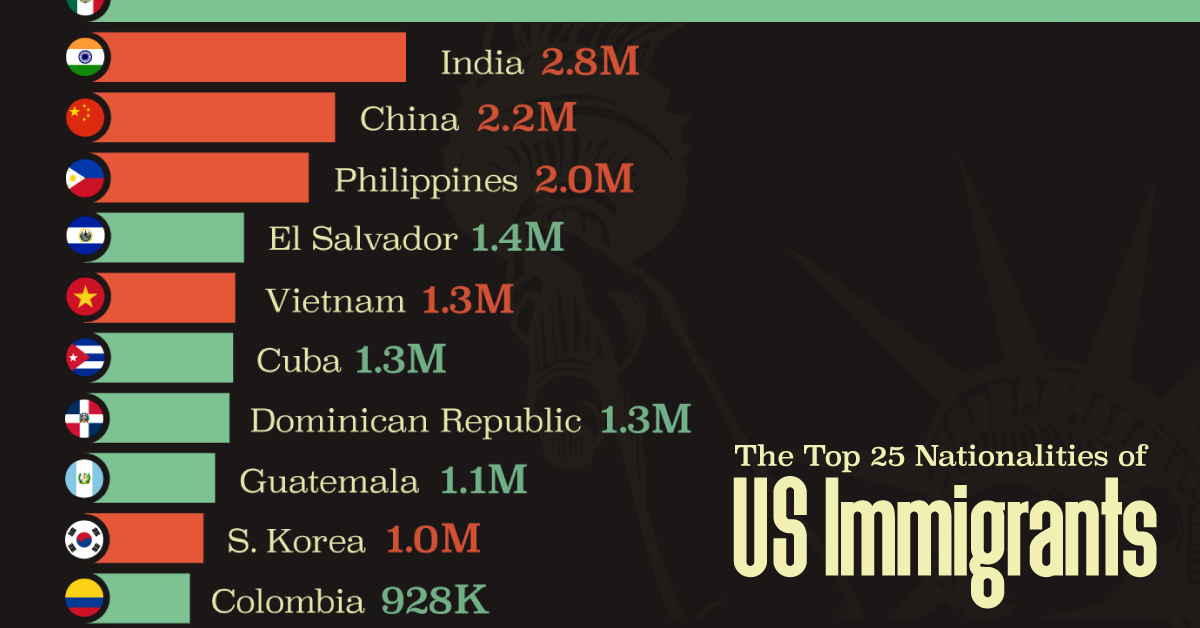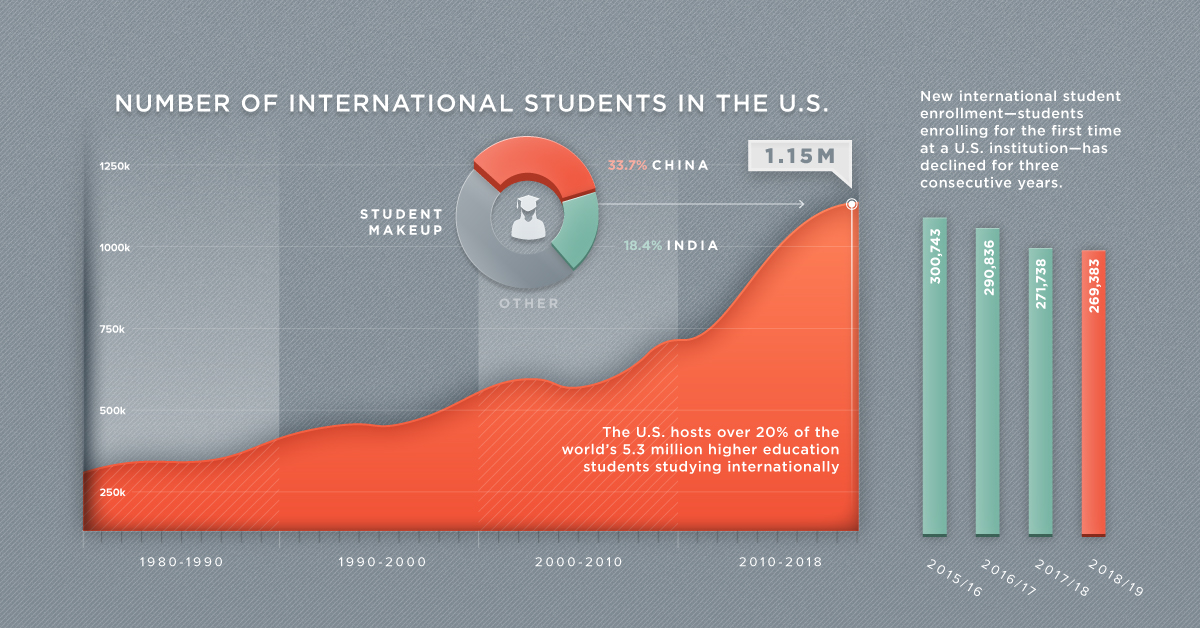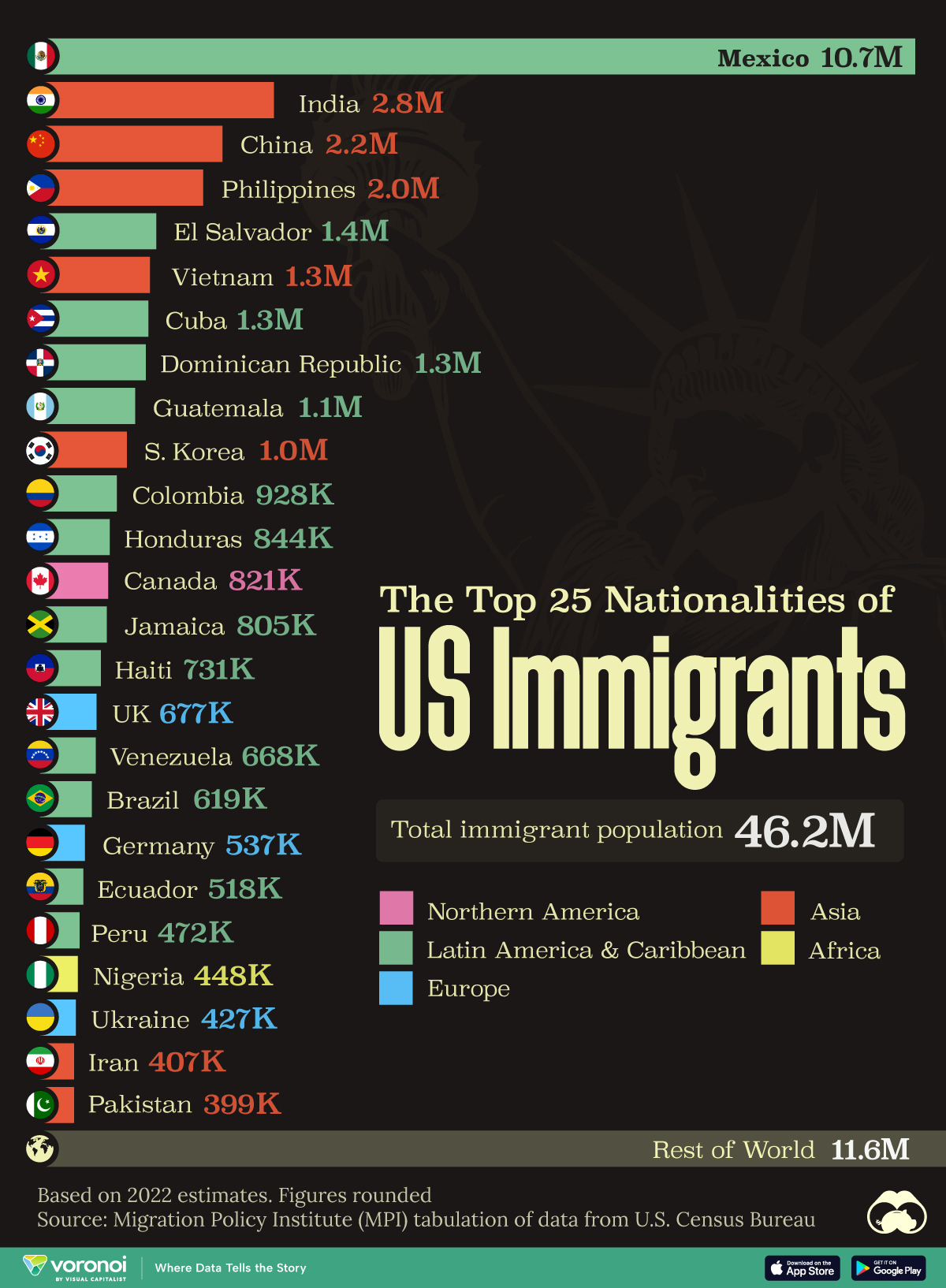Misc
The Impact of International Students on the U.S. Economy

The Economic Impact of America’s International Students
For decades, the U.S. has been the top destination for students looking to study abroad.
It’s easy to see why. Not only does the country provide access to world-class economic hubs like Silicon Valley, but the U.S. is also home to 14 of the top 20 universities in the world, many of which are famed for their research and alumni networks.
Yet, there is cause for concern.
International enrollments in the U.S. have slowed, while other countries are attracting a larger share of the global talent pool. To help us understand what’s at stake if enrollments continue to decline, today’s infographic shows the impact of international students on the U.S. economy.
Driving American Innovation and Growth
International students and scholars are a vital economic asset, and America’s ability to attract them puts the country in an enviable position.
First, there are the direct economic benefits which result from tuition fees and living expenses. Throughout the 2018/2019 school year, these benefits totaled $41 billion, a comparable value to many other American exports:
| Export | Value (2018) |
|---|---|
| Automobiles | $158B |
| Commercial Aircraft | $131B |
| Pharmaceuticals | $51B |
| Education Exports | $41B |
| Telecommunications Equipment | $36B |
| Soybeans | $17B |
Source: NAFSA, Evans, WorldCity
Even after graduation, however, international students and scholars continue to make significant contributions to the U.S. economy.
For example, attracting the world’s brightest minds helps to grow the knowledge economy in the United States, and 40% of American Nobel Prizes won in chemistry, medicine, and physics since 2000 have been awarded to immigrants. Furthermore, students who return home often do so with a network of connections and an appreciation for American culture, thus promoting U.S. international leadership.
Finally, these individuals can also go on to become successful entrepreneurs and business leaders in the U.S. economy. The list is long, but here are two noteworthy examples:
- Elon Musk, known for founding Paypal, Tesla, and SpaceX, was born in South Africa. He received two Bachelor’s degrees from the University of Pennsylvania before founding his first business.
- Satya Nadella, CEO of Microsoft, was an international student from India. He received an M.S. from the University of Wisconsin and an MBA from the University of Chicago before helping Microsoft develop its cloud computing capabilities.
Cause for Concern
In recent years, however, the number of new international students enrolling at U.S. institutions has been on the decline:
| School Year | New International Student Enrollments in the U.S. | Percent Change |
|---|---|---|
| 2013/14 | 270,128 | -- |
| 2014/15 | 293,766 | 8.8% |
| 2015/16 | 300,743 | 2.4% |
| 2016/17 | 290,836 | -3.3% |
| 2017/18 | 271,738 | -6.6% |
| 2018/19 | 269,383 | -0.9% |
Source: Institute of International Education
With so many opportunities and success stories, why have international enrollments slowed? A survey of 509 higher education institutions in the U.S. revealed the top reasons for declining international enrollments:
| Cited Reason for Decline in Enrollment | % of Institutions (Fall 2016) | % of Institutions (Fall 2017) | % of Institutions (Fall 2018) |
|---|---|---|---|
| Visa Application Process (delays/denials) | 34% | 68% | 83% |
| Social and Political Environment | 15% | 57% | 60% |
| Enroll in Another Country’s Institutions | 19% | 54% | 59% |
| Cost of Tuition | 51% | 55% | 57% |
| Feeling Unwelcome | - | 49% | 50% |
| Securing a Job | - | 41% | 44% |
| Physical Safety | 12% | 33% | 44% |
Source: NAFSA
Critically, the two most common reasons for declining enrollment—visa applications and the social and political environment—suggest that the quality of an American education is not the issue. Rather, it would appear that students are being discouraged from coming to the United States.
When we discourage or turn away international students, we lose much more than the students themselves… We lose their inventions and innovation, their collaborative input and their contributions to our communities.
– Dr. Martha E. Pollack, President, Cornell University
At the same time, other countries are taking proactive measures to attract global talent.
Australia
Australia allows its international students to work for up to 18 months after graduation. This limit can increase to 4 years for graduates of high-demand occupations. In 2018, the country saw a 15% increase in international enrollments.
Canada
Canada, a country distinguished for its multiculturalism, is quickly becoming an attractive destination for international students. The country offers expedited visa processing for qualified individuals, as well as a 3-year work visa for graduates. In 2017, international enrollments in Canada grew by an impressive 20%.
Potential Consequences
The world’s brightest minds are an important asset for continued innovation and growth, and today, there is a mass of countries welcoming them with open arms.
While the U.S. is still the preferred destination for international students and scholars, the country’s leadership in this space is at risk. In fact, since 2001, the share of international students in America has fallen from 28% to 21%.
Will the U.S be able to maintain global competitiveness if the number of new international students enrolling continues to fall? Can the country work to cultivate a more welcoming and barrier-free route to higher education?
These are potent questions that will need to be answered, especially with a sizable economic impact on the line.
Misc
The Top 25 Nationalities of U.S. Immigrants
Mexico is the largest source of immigrants to the U.S., with almost 11 million immigrants.

The Top 25 Nationalities of U.S. Immigrants
This was originally posted on our Voronoi app. Download the app for free on iOS or Android and discover incredible data-driven charts from a variety of trusted sources.
The United States is home to more than 46 million immigrants, constituting approximately 14% of its total population.
This graphic displays the top 25 countries of origin for U.S. immigrants, based on 2022 estimates. The data is sourced from the Migration Policy Institute (MPI), which analyzed information from the U.S. Census Bureau’s 2022 American Community Survey.
In this context, “immigrants” refer to individuals residing in the United States who were not U.S. citizens at birth.
Mexico Emerges as a Leading Source of Immigration
Mexico stands out as the largest contributor to U.S. immigration due to its geographical proximity and historical ties.
Various economic factors, including wage disparities and employment opportunities, motivate many Mexicans to seek better prospects north of the border.
| Country | Region | # of Immigrants |
|---|---|---|
| 🇲🇽 Mexico | Latin America & Caribbean | 10,678,502 |
| 🇮🇳 India | Asia | 2,839,618 |
| 🇨🇳 China | Asia | 2,217,894 |
| 🇵🇭 Philippines | Asia | 1,982,333 |
| 🇸🇻 El Salvador | Latin America & Caribbean | 1,407,622 |
| 🇻🇳 Vietnam | Asia | 1,331,192 |
| 🇨🇺 Cuba | Latin America & Caribbean | 1,312,510 |
| 🇩🇴 Dominican Republic | Latin America & Caribbean | 1,279,900 |
| 🇬🇹 Guatemala | Latin America & Caribbean | 1,148,543 |
| 🇰🇷 Korea | Asia | 1,045,100 |
| 🇨🇴 Colombia | Latin America & Caribbean | 928,053 |
| 🇭🇳 Honduras | Latin America & Caribbean | 843,774 |
| 🇨🇦 Canada | Northern America | 821,322 |
| 🇯🇲 Jamaica | Latin America & Caribbean | 804,775 |
| 🇭🇹 Haiti | Latin America & Caribbean | 730,780 |
| 🇬🇧 United Kingdom | Europe | 676,652 |
| 🇻🇪 Venezuela | Latin America & Caribbean | 667,664 |
| 🇧🇷 Brazil | Latin America & Caribbean | 618,525 |
| 🇩🇪 Germany | Europe | 537,484 |
| 🇪🇨 Ecuador | Latin America & Caribbean | 518,287 |
| 🇵🇪 Peru | Latin America & Caribbean | 471,988 |
| 🇳🇬 Nigeria | Africa | 448,405 |
| 🇺🇦 Ukraine | Europe | 427,163 |
| 🇮🇷 Iran | Middle East | 407,283 |
| 🇵🇰 Pakistan | Asia | 399,086 |
| Rest of World | 11,637,634 | |
| Total | 46,182,089 |
Mexicans are followed in this ranking by Indians, Chinese, and Filipinos, though most immigrants on this list come from countries in the Latin American and Caribbean region.
On the other hand, only three European countries are among the top sources of U.S. immigrants: the UK, Germany, and Ukraine.
Immigration continues to be a significant factor contributing to the overall growth of the U.S. population. Overall population growth has decelerated over the past decade primarily due to declining birth rates.
Between 2021 and 2022, the increase in the immigrant population accounted for 65% of the total population growth in the U.S., representing 912,000 individuals out of nearly 1.4 million.
If you enjoyed this post, be sure to check out Visualized: Why Do People Immigrate to the U.S.? This visualization shows the different reasons cited by new arrivals to America in 2021.
-

 Brands1 week ago
Brands1 week agoCharted: How the Logos of Select Fashion Brands Have Evolved
-

 Stocks2 weeks ago
Stocks2 weeks agoThe Growth of a $1,000 Equity Investment, by Stock Market
-

 Markets2 weeks ago
Markets2 weeks agoMapped: Europe’s GDP Per Capita, by Country
-

 Money2 weeks ago
Money2 weeks agoCharted: What Frustrates Americans About the Tax System
-

 Technology2 weeks ago
Technology2 weeks agoCountries With the Highest Rates of Crypto Ownership
-

 Mining2 weeks ago
Mining2 weeks agoWhere the World’s Aluminum is Smelted, by Country
-

 Personal Finance2 weeks ago
Personal Finance2 weeks agoVisualizing the Tax Burden of Every U.S. State
-

 Automotive2 weeks ago
Automotive2 weeks agoHow People Get Around in America, Europe, and Asia















